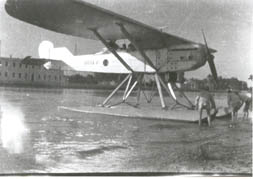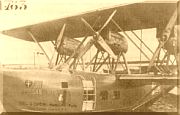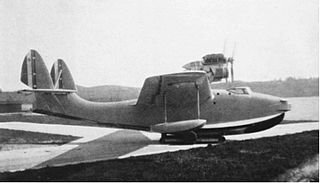
The Fiat CR.1 was an Italian biplane fighter aircraft of the 1920s. Of wood-and-fabric construction, it was designed by Celestino Rosatelli, from whom it gained the 'CR' designation. Its most distinctive feature was that the lower wings were longer than the upper ones.

The Breda A.7 was a reconnaissance aircraft developed in Italy for use by the Regia Aeronautica in 1929. It was a braced parasol monoplane of conventional configuration with tailskid undercarriage. The pilot and observer sat in tandem, open cockpits. A single prototype of a long-range example, originally designated A.7 Raid and later A.16 was also constructed, but the air force showed no interest in it.

The Savoia-Marchetti SM.78 was an Italian bomber/reconnaissance biplane flying boat of the early 1930s.

The Savoia-Marchetti SM.62 was an Italian single-engine maritime patrol flying boat produced from 1926. It served with the Regia Aeronautica and with a number of foreign users, and was produced in Spain and the Soviet Union. Some of the Spanish aircraft were still in service during the Spanish Civil War.

The Caproni Ca.73 was an inverted sesquiplane aircraft designed produced by the Italian aircraft manufacturer Caproni.

The CANT 22 was a flying boat airliner built in Italy in the 1920s and operated by Società Italiana Servizi Aerei (SISA) on their Adriatic routes. It was a conventional biplane design with unstaggered wings braced by Warren trusses. The three engines were mounted in nacelles carried in the interplane gap. Accommodation for passengers was provided within the hull, but the pilots sat in an open cockpit. Originally designed to carry eight passengers, an engine upgrade on later examples allowed the addition of two more seats.

The Macchi L.2 was an Italian biplane flying boat developed from the earlier Macchi L.1, itself a copy of a captured Austrian Lohner flying boat.

The FBA Type H was a French reconnaissance flying boat produced in large numbers in France and Italy during World War I by Franco-British Aviation.

The Macchi L.3, or later Macchi M.3, was an Italian biplane flying boat developed from the earlier L.2.

The Savoia-Marchetti S.59 was a 1920s Italian reconnaissance/bomber flying boat designed and built by Savoia-Marchetti for the Regia Aeronautica.

The Lohner L was a reconnaissance flying boat produced in Austria-Hungary during World War I. It was a two-bay biplane of typical configuration for the flying boats of the day, with its pusher engine mounted on struts in the interplane gap. The pilot and observer sat side by side in an open cockpit, and both the upper and lower sets of wings featured sweepback.

The Macchi M.5 was an Italian single-seat fighter flying boat designed and built by Nieuport-Macchi at Varese. It was extremely manoeuvrable and agile and matched the land-based aircraft it had to fight.

The Macchi M.7 was an Italian single-seat fighter flying boat designed by Alessandro Tonini and built by Macchi. A modified version of the M.7, the M.7bis won the Schneider Trophy in 1921.
The Macchi M.8 was an Italian reconnaissance/bomber flying boat designed by Alessandro Tonini and built by Macchi. It was used by the Italian Naval Aviation and was later flown by crews from the United States Navy.

The Macchi M.18 was a flying boat designed by Alessandro Tonini and produced by Macchi in Italy in the early 1920s. Originally planned as a passenger aircraft, it entered production as a bomber before eventually being offered on the civil market that it was originally intended for.

The Macchi M.71 was an Italian flying boat fighter of the 1930s designed and manufactured by Macchi.

The Macchi M.6 was an Italian flying boat fighter prototype of 1917.

The Macchi M.C.99 was a prototype 1930s Italian twin-engined torpedo-bomber flying boat designed and built by Macchi.
The Caproni Ca.61 was an Italian heavy day bomber aircraft of 1922. It was the final development of the Caproni three engine, twin boom biplane types developed during World War I, but it was not put into production.
The Macchi M.C.77 was a reconnaissance bomber flying boat built by Macchi in the thirties and remained at the prototype stage.


















